The Effect of W Content on the Microstructure, Mechanics and Electrical Performance of an FeCrCo Alloy
Abstract
1. Introduction
2. Experiments
2.1. Material Preparation
2.2. Characterization
3. Results and Discussions
3.1. Microstructure Analysis
3.2. Analysis of Mechanical Properties
3.3. Analysis of Electrical Performance
Electrical Resistivity
4. Conclusions
- The content of W is a key factor affecting the composition of FeCrCoW alloy phases. The FCC phase appears when the content of W increases. In addition, the layer fault energy of the alloy decreases with the addition of 3.4 at% W content, which leads to the occurrence of twins. Considering the improvement in strength and ductility, it was clearly indicated that W has a beneficial impact on a combination of properties in the FeCrCo alloy. W element plays a role in refining grain and strengthening the solid solution.
- The variation in the content of W was an important factor affecting the electrical resistivity of the FeCrCoW alloy. W exists in the alloy in the form of a solid solution atom. The maximum resistivity value is 170 ± 1.5 μΩ·cm with the addition of 2.1 at% W. The increase in the electrical resistivity caused by the solid solution was mainly due to the dissimilar atom’s dissolution, which caused the distortion of the solvent lattice.
- The change in the Kernel average misorientation and twin were also important factors affecting the resistivity of the alloy. The average KAM value of the W2.1 alloy is smaller than that of the W3.4 alloy. Therefore, compared with the W2.1 alloy, the resistivity of the W3.4 alloy decreased by 17%. Therefore, FeCrCoW alloys can be used as a promising resistive material.
Author Contributions
Funding
Data Availability Statement
Acknowledgments
Conflicts of Interest
References
- Mooij, J.H. Electrical conduction in concentrated disordered transition metal alloys. Phys. Status Solidi A 1973, 17, 512–530. [Google Scholar] [CrossRef]
- Lukose, C.C.; Zoppi, G.; Birkett, M. Mn3Ag1−xCuxN antiperovskite thin films with ultra-low temperature coefficient of resistance. J. Mater. Sci. Technol. 2022, 99, 138–147. [Google Scholar] [CrossRef]
- Fiorillo, A.S.; Critello, C.D.; Pullano, S.A. Theory, technology and applications of piezoresistive sensors: A review. Sens. Actuators A Phys. 2018, 281, 165–175. [Google Scholar] [CrossRef]
- Hui, Z.; Zhu, Q.; Liu, C.; Wei, J.; Tang, J.; Ye, L.; Ye, X.; Wang, X.; Zuo, X.; Zhu, X. Synthesis and physical properties of antiperovskite CuNFe3 thin films via solution processing for room temperature soft-magnets. Coatings 2020, 10, 270. [Google Scholar] [CrossRef]
- Simi, M. Microcontroller-based Readout of Resistive Sensors. IFAC-PapersOnLine 2022, 55, 242–247. [Google Scholar] [CrossRef]
- Kreislova, K.; Vlachova, M. Monitoring of the atmospheric corrosivity by resistive sensors. Koroze Ochr. Mater. 2021, 65, 86–91. [Google Scholar] [CrossRef]
- Kilinc, N.; Sanduvac, S.; Erkovan, M. Platinum-Nickel alloy thin films for low concentration hydrogen sensor application. J. Alloy. Compd. 2022, 892, 162237. [Google Scholar] [CrossRef]
- Qizhou, C.; Can, X.; Xu, C.; Weiguo, X.; Jingfan, C.; Zhe, C.; Ji, C. Effect of Mn and Mo on the microstructure and electrical resistivity of Ti-Al alloy prepared by mechanical alloying and spark plasma sintering. J. Alloy. Compd. 2023, 947, 169608. [Google Scholar]
- Azeem, M.M.; Wang, Q.; Zhang, Y.; Liu, S.; Zubair, M. Effect of Grain Boundary on Diffusion of P in Alpha-Fe: A Molecular Dynamics Study. Front. Phys. 2019, 7, 97. [Google Scholar] [CrossRef]
- Naohara, T.; Inoue, A.; Minemura, T.; Masumoto, T.; Kumada, K. Microstructures, mechanical properties, and electrical resistivity of rapidly quenched Fe-Cr-Al alloys. Metall. Trans. A 1982, 13, 337–343. [Google Scholar] [CrossRef]
- Samrand, S.; Sheng, G.; Paul, E.; Qiang, H.; Anders, P. Balancing Scattering Channels: A Panoscopic Approach toward Zero Temperature Coefficient of Resistance Using High-Entropy Alloys. Adv. Mater. 2019, 31, 1805392. [Google Scholar]
- Jiro, K. Magnetic properties, electrical resistivity, and hardness of high-entropy alloys FeCoNiPd and FeCoNiPt. J. Magn. Magn. Mater. 2022, 563, 170024. [Google Scholar]
- Han, L.; Maccari, F.; Souza Filho, I.R.; Peter, N.J.; Wei, Y.; Gault, B.; Gutfleisch, O.; Li, Z.; Raabe, D. A mechanically strong and ductile soft magnet with extremely low coercivity. Nature 2022, 608, 310–316. [Google Scholar] [CrossRef] [PubMed]
- Chen, S.K.; Kao, Y.F. Near-constant resistivity in 4.2-360 K in a B2 Al2.08CoCrFeNi. AIP Adv. 2012, 2, 012111. [Google Scholar] [CrossRef]
- Nakamura, N.; Masumoto, H. Strain Gage Factor and Electrical Properties of Fe-Cr-Co-W and Fe-Cr-Co-Mo Alloys. J. Jpn. Inst. Met. 1987, 51, 1201–1208. [Google Scholar] [CrossRef]
- Zhaolong, X.; Lin, Z.; Yan, X.; Bailing, A.; Rongmei, N.; Masoud, M.; Theo, S.; Jun, L.; Goddard, E.G.; Tiannan, M.; et al. Ultrafine microstructure and hardness in Fe-Cr-Co alloy induced by spinodal decomposition under magnetic field. Mater. Des. 2021, 199, 109383. [Google Scholar]
- Stel’mashok, S.I.; Milyaev, I.M.; Yusupov, V.S.; Milyaev, A.I. Magnetic and Mechanical Properties of Hard Magnetic Alloys 30Kh21K3M and 30Kh20K2M2V. Met. Sci. Heat Treat. 2017, 58, 622–627. [Google Scholar] [CrossRef]
- Shuya, Z.; Qiankun, Y.; Kefu, G.; Dingshun, Y.; Yong, Z.; Chang, L.; Zhiming, L. A strong ferritic high-resistivity multicomponent alloy with tunable ordered coherent multicomponent nanoprecipitates. Acta Mater. 2022, 238, 118209. [Google Scholar]
- Bishara, H.; Lee, S.; Brink, T.; Ghidelli, M.; Dehm, G. Understanding grain boundary electrical resistivity in Cu: The effect of boundary structure. ACS Nano 2021, 15, 16607–16615. [Google Scholar] [CrossRef]
- Aisaka, T.; Shimizu, M. Electrical Resistance, Thermal Conductivity and Thermoelectric Power of Transition Metals at High Temperatures. J. Phys. Soc. Jpn. 2007, 28, 646–654. [Google Scholar] [CrossRef]
- Altafi, M.; Ghasemi, A.; Sharifi, E.M. The influence of cold rolling and thermomagnetic treatment on the magnetic and mechanical properties of Fe-23Cr-9Co alloy. J. Magn. Magn. Mater. 2019, 491, 165537. [Google Scholar] [CrossRef]
- Karaali, A.; Mirouh, K.; Hamamda, S.; Guiraldenq, P. Microstructural study of tungsten influence on Co-Cr alloys. Mater. Sci. Eng. A 2004, 390, 255–259. [Google Scholar] [CrossRef]
- Chen, Y.; Liu, Q.; Xiao, W.; Ping, D.; Wang, Y.; Zhao, X. Deformation-induced nontetragonality of martensite in carbon steels. Mater. Lett. 2018, 227, 213–216. [Google Scholar] [CrossRef]
- Galimberti, P.; Lay, S.; Antoni-Zdziobek, A.; Coindeau, S.; Véron, M.; Bley, F.; De Boissieu, M. Precipitation and hardening behaviour of the Fe20Co18W alloy aged at 800 °C. Intermetallics 2011, 19, 556–562. [Google Scholar] [CrossRef]
- Guoai, H.; Cunxiao, H.; Xiaofei, S.; Houxuan, H.; Qiang, P.; Shuanghui, X.; Zhiqiang, F.; Cheng, H. Deciphering the effect of W and Mo co-additions on recrystallization behavior and strengthening mechanism of CrCoNi medium entropy alloy. J. Alloy. Compd. 2022, 923, 166404. [Google Scholar]
- An, F.; Hou, J.; Liu, J.; Qian, B.; Lu, W. Deformable κ phase induced deformation twins in a CoNiV medium entropy alloy. Int. J. Plast. 2023, 160, 103509. [Google Scholar] [CrossRef]
- Tasaki, W.; Sawaguchi, T.; Tsuchiya, K. EBSD analysis of dual γ/ε phase microstructures in tensile-deformed Fe-Mn-Si shape memory alloy. J. Alloy. Compd. 2019, 797, 529–536. [Google Scholar] [CrossRef]
- Shunlong, T.; Meng, Z.; Yi, Z.; Deye, X.; Zhiyang, Z.; Xianhua, Z.; De, L.; Xu, L.; Baohong, T.; Yanlin, J.; et al. Improved microstructure, mechanical properties and electrical conductivity of the Cu-Ni-Sn-Ti-Cr alloy due to Ce micro-addition. Mater. Sci. Eng. A 2023, 871, 144910. [Google Scholar]
- Chang, R.; Fang, W.; Bai, X.; Xia, C.; Zhang, X.; Yu, H.; Liu, B.; Yin, F. Effects of tungsten additions on the microstructure and mechanical properties of CoCrNi medium entropy alloys. J. Alloy. Compd. 2019, 790, 732–743. [Google Scholar] [CrossRef]
- Zhang, J.; Zhang, H.; Li, Q.; Cheng, L.; Ye, H.; Zheng, Y.; Lu, J. The physical origin of observed repulsive forces between general dislocations and twin boundaries in FCC metals: An atom-continuum coupling study. J. Mater. Sci. Technol. 2022, 109, 221–227. [Google Scholar] [CrossRef]
- Jiang, S.; Wang, Y.; Zhang, Y.; Xing, X. Role of stacking faults in martensite transformation of FeMnSiCrNi shape memory alloy subjected to plastic deformation at high temperatures. Intermetallics 2020, 124, 106841. [Google Scholar] [CrossRef]
- Ji, X.; Fu, L.; Zheng, H.; Peng, J.; Wang, W.; Shan, A. Ultrafine lamellar microstructure with greatly enhanced strength and ductility of martensite steel via heavily warm rolling of metastable austenite. Mater. Sci. Eng. A 2021, 826, 141977. [Google Scholar] [CrossRef]
- Liu, F.; Xie, G.; Wang, S.; Yang, J.; Chen, C.; Liu, X. Excellent combination of mechanical properties and electrical conductivity obtained by minute addition of alloying elements and nanometer scaled Al2O3 in copper alloy. Mater. Sci. Eng. A 2023, 867, 144689. [Google Scholar] [CrossRef]
- Chen, J.H.; Cao, R. Micromechanism of Cleavage Fracture of Metals; Elsevier: Amsterdam, The Netherlands, 2015; pp. 3–6. [Google Scholar]
- Zhu, S.; Gan, K.; Yan, D.; Han, L.; Wu, P.; Li, Z. Multiple minor elements improve strength-ductility synergy of a high-entropy alloy. Mater. Sci. Eng. A 2022, 840, 142901. [Google Scholar] [CrossRef]
- Jiang, Z.; Wei, R.; Wang, W.; Li, M.; Han, Z.; Yuan, S.; Zhang, K.; Chen, C.; Wang, T.; Li, F. Achieving high strength and ductility in Fe50Mn25Ni10Cr15 medium entropy alloy via Al alloying. J. Mater. Sci. Technol. 2022, 100, 20–26. [Google Scholar] [CrossRef]
- Shi, B.; Xin, D.; Chen, X.; Wang, Y.; Singh, A. Fabrication of high-strength dual FCC phase Co-Cr-Fe-Ni-Cu-Mo high entropy alloy by plasma arc additive manufacturing using a combined cable wire. Mater. Lett. 2023, 337, 133983. [Google Scholar] [CrossRef]
- Nakamichi, I. Electrical Resistivity and Grain Boundaries in Metals. Mater. Sci. Forum 1996, 207, 207–209. [Google Scholar] [CrossRef]
- Xie, M.; Zhou, P.; Huang, W.; Chen, H.; Gong, L.; Xie, W.; Wang, H.; Yang, B. Annealing effects on the microstructure, strength, and electrical resistivity in a dual-phase Cu-15wt%Ag alloy. Mater. Sci. Eng. A 2022, 840, 143004. [Google Scholar] [CrossRef]
- Zhang, J.; Ma, M.; Shen, F.; Yi, D.; Wang, B. Influence of deformation and annealing on electrical conductivity, mechanical properties and texture of Al-Mg-Si alloy cables. Mater. Sci. Eng. A 2018, 710, 27–37. [Google Scholar] [CrossRef]
- Wang, P.P.; Wang, X.J.; Du, J.L.; Ren, F.; Zhang, Y.; Zhang, X.; Fu, E.G. The temperature and size effect on the electrical resistivity of Cu/V multilayer films. Acta Mater. 2017, 126, 294–301. [Google Scholar] [CrossRef]
- Bonny, G.; Castin, N.; Domain, C.; Olsson, P.; Verreyken, B.; Pascuet, M.I.; Terentyev, D. Density functional theory-based cluster expansion to simulate thermal annealing in FeCrW alloys. Philos. Mag. 2017, 97, 299–317. [Google Scholar] [CrossRef]
- Mott, N.F. Electrons in transition metals. Adv. Phys. 1964, 13, 325–422. [Google Scholar] [CrossRef]
- Wang, C.; Li, X.; Li, Z.; Wang, Q.; Zheng, Y.; Ma, Y.; Bi, L.; Zhang, Y.; Yuan, X.; Zhang, X.; et al. The resistivity-temperature behavior of AlxCoCrFeNi high-entropy alloy films. Solid Film. 2020, 700, 137895. [Google Scholar] [CrossRef]
- Guo, T.; Wei, S.; Wang, C.; Li, Q.; Jia, Z. Texture evolution and strengthening mechanism of single crystal copper during ECAP. Mater. Sci. Eng. A 2019, 759, 97–104. [Google Scholar] [CrossRef]
- Wei, X.; Tao, J.; Liu, Y.; Bao, R.; Li, F.; Fang, D.; Li, C.; Yi, J. High strength and electrical conductivity of copper matrix composites reinforced by carbon nanotube-graphene oxide hybrids with hierarchical structure and nanoscale twins. Diam. Relat. Mater. 2019, 99, 107537. [Google Scholar] [CrossRef]
- Hussey, N.E.; Takenaka, K.; Takagi, H. Universality of the Mott-Ioffe-Regel limit in metals. Philos. Mag. 2004, 84, 2847–2864. [Google Scholar] [CrossRef]
- Kourov, N.I.; Pushin, V.G.; Korolev, A.V.; Knyazev, Y.V.; Ivchenko, M.V.; Ustyugov, Y.M. Peculiar features of physical properties of the rapid quenched AlCrFeCoNiCu high-entropy alloy. J. Alloy. Compd. 2015, 636, 304–309. [Google Scholar] [CrossRef]
- Kao, Y.-F.; Chen, S.-K.; Chen, T.-J.; Chu, P.-C.; Yeh, J.-W.; Lin, S.-J. Electrical, magnetic, and Hall properties of AlxCoCrFeNi high-entropy alloys. J. Alloy. Compd. 2011, 509, 1607–1614. [Google Scholar] [CrossRef]
- Cote, P.J.; Meisel, L.V. Origin of saturation effects in electron transport. Phys. Rev. Lett. 1978, 40, 1586–1589. [Google Scholar] [CrossRef]
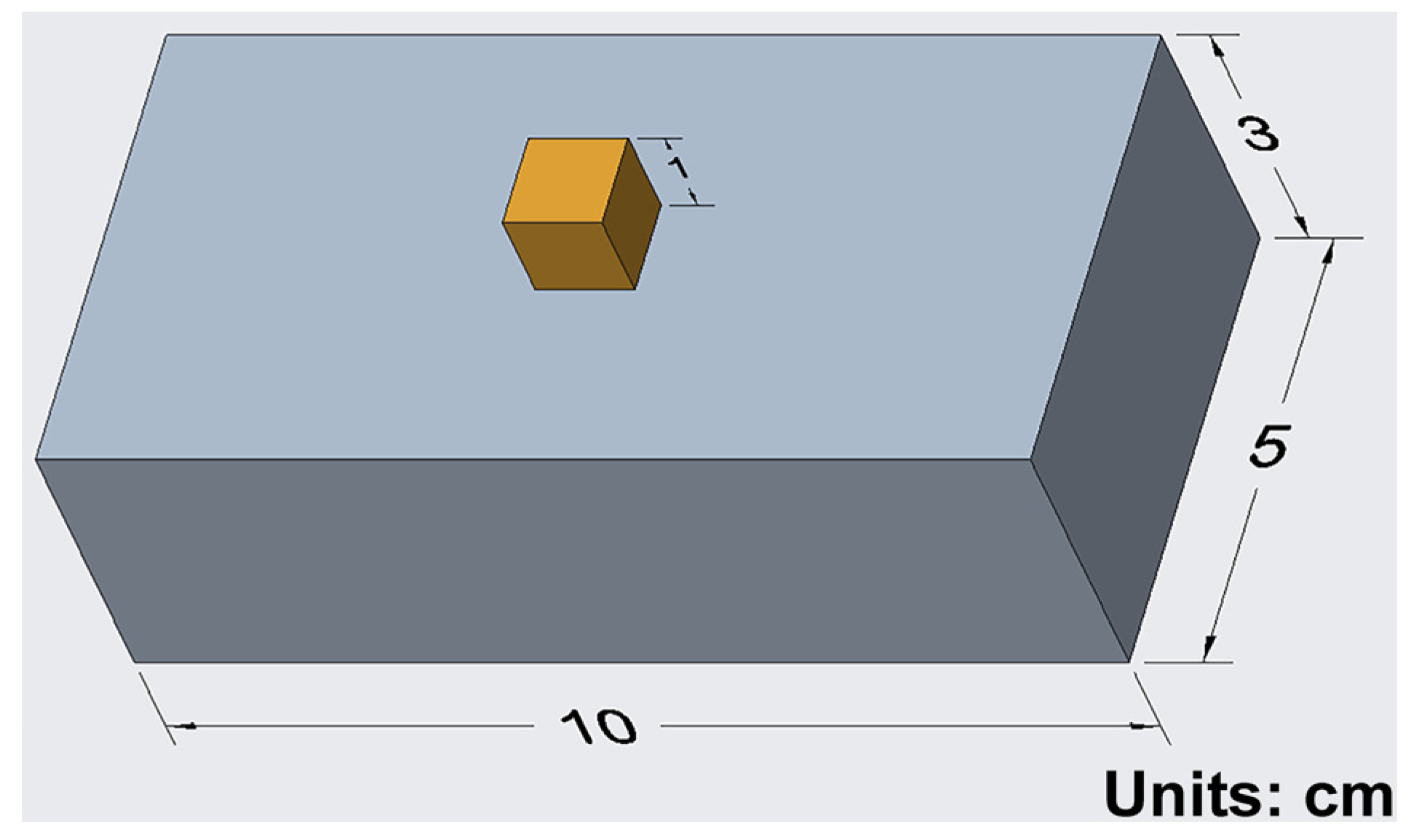
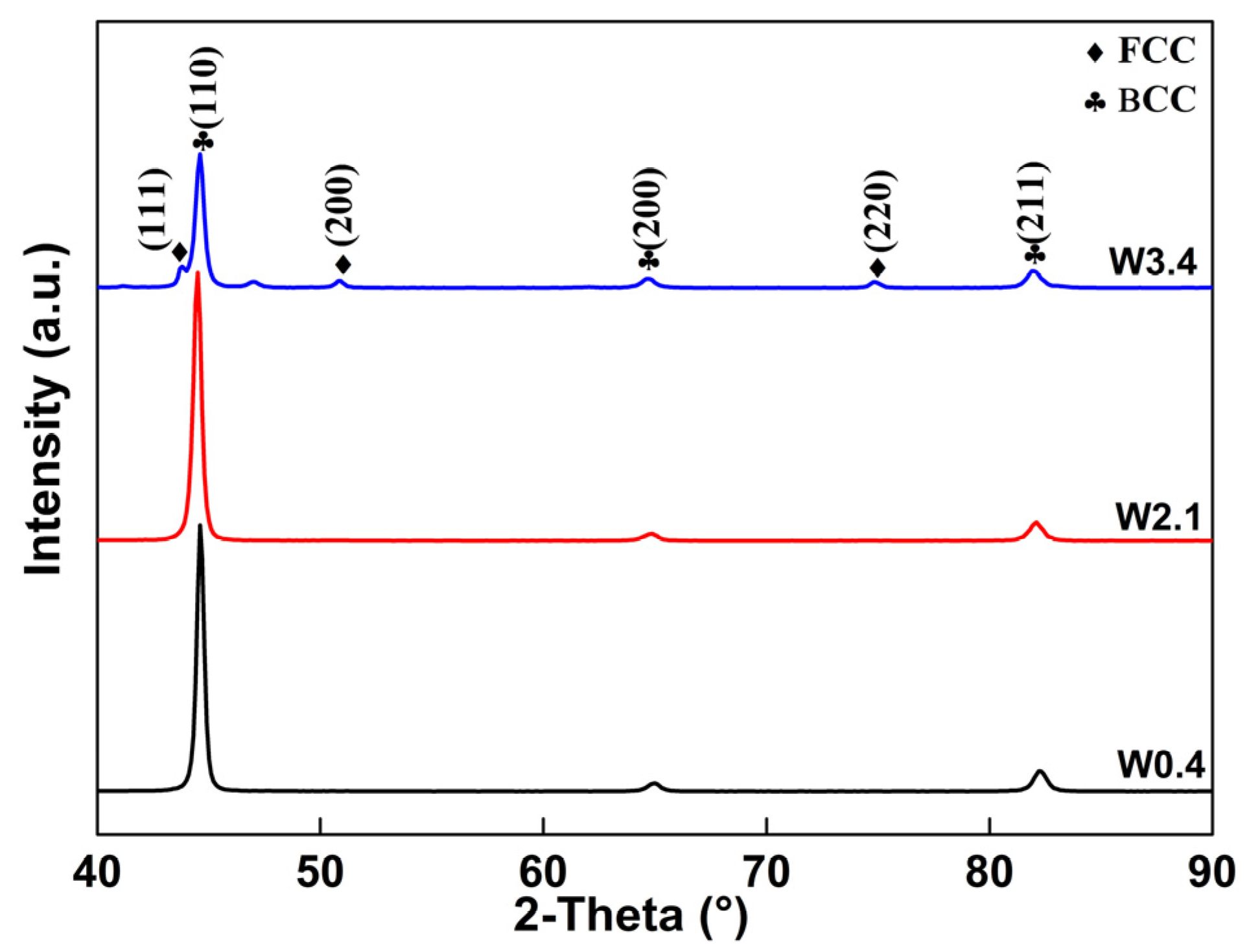

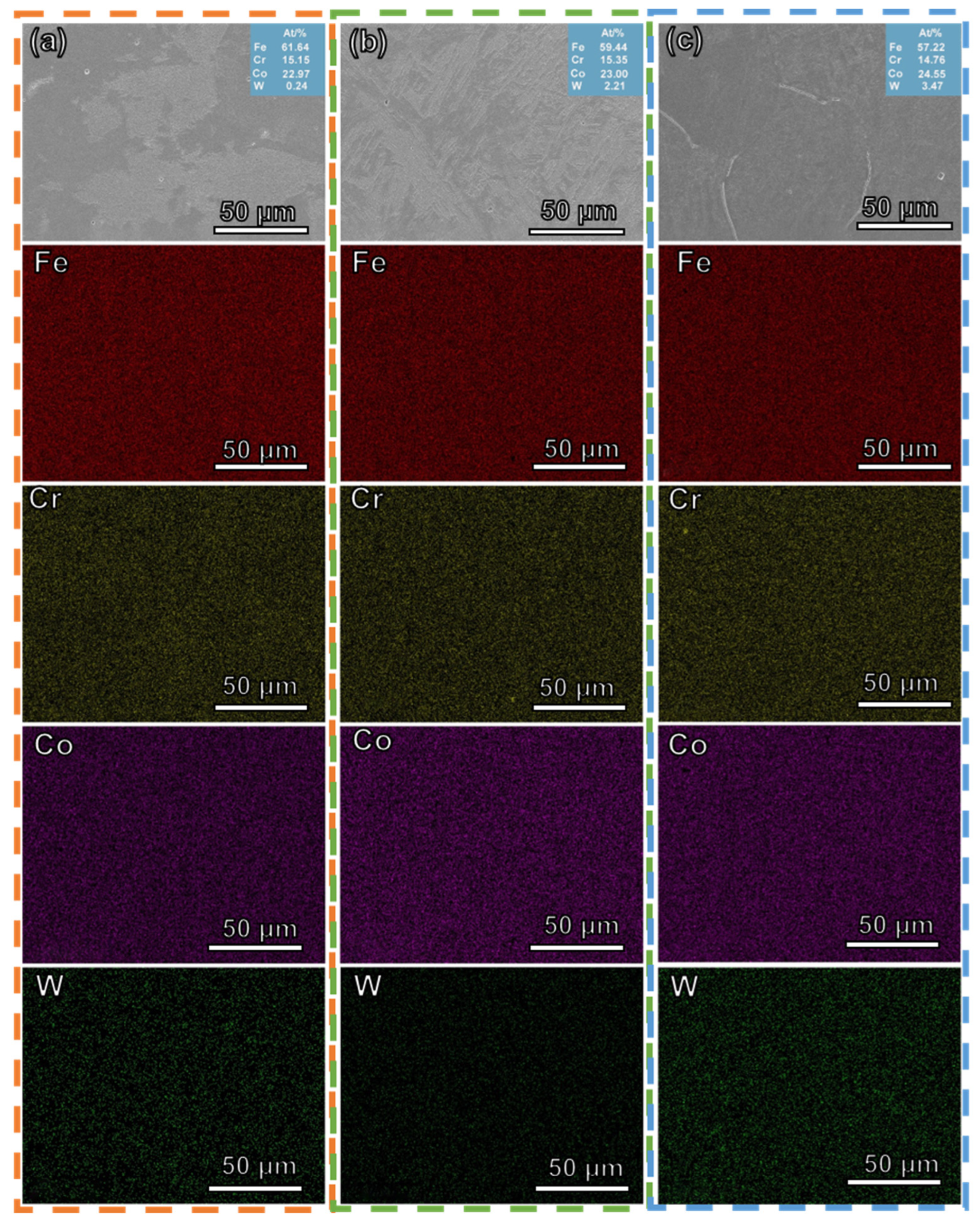
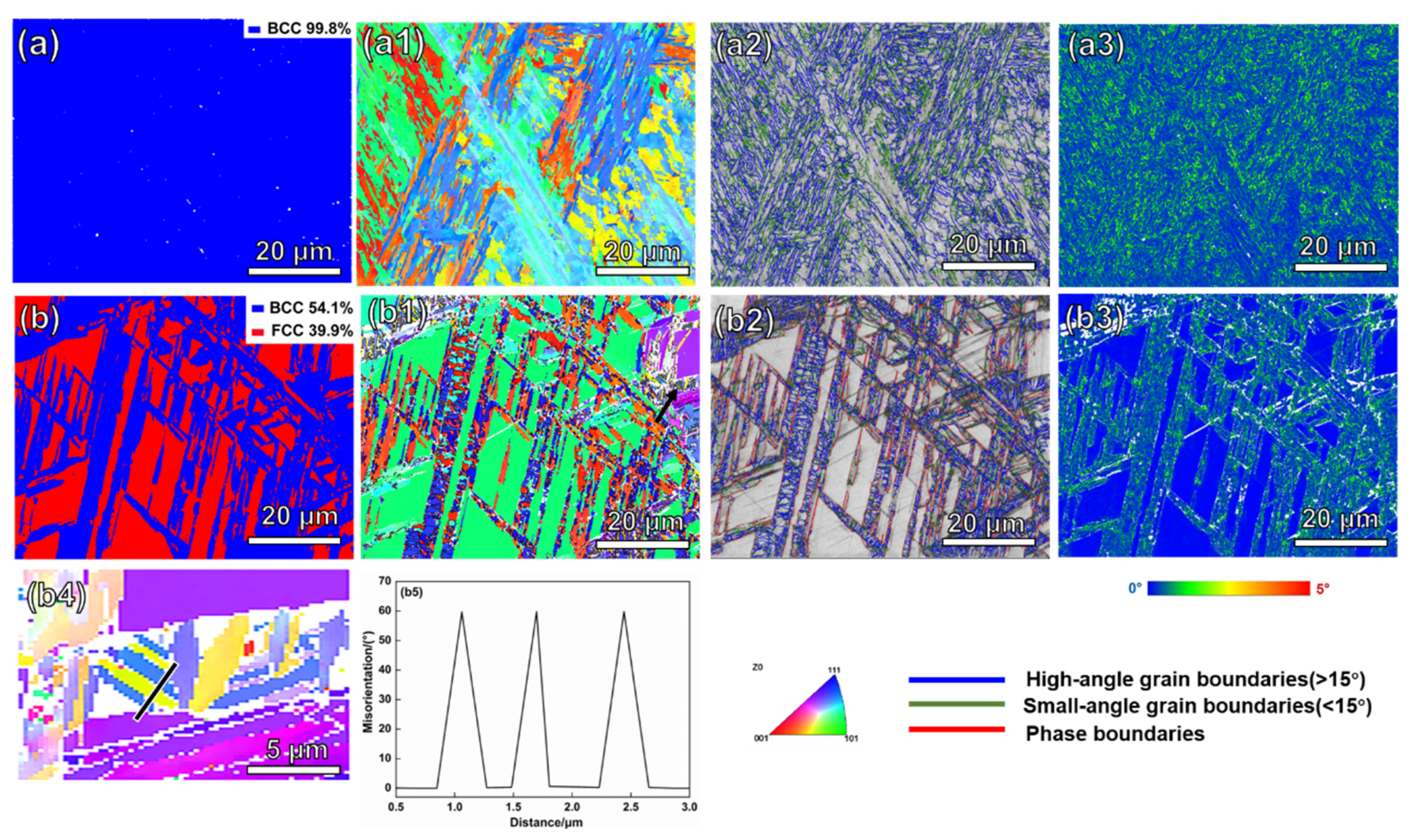
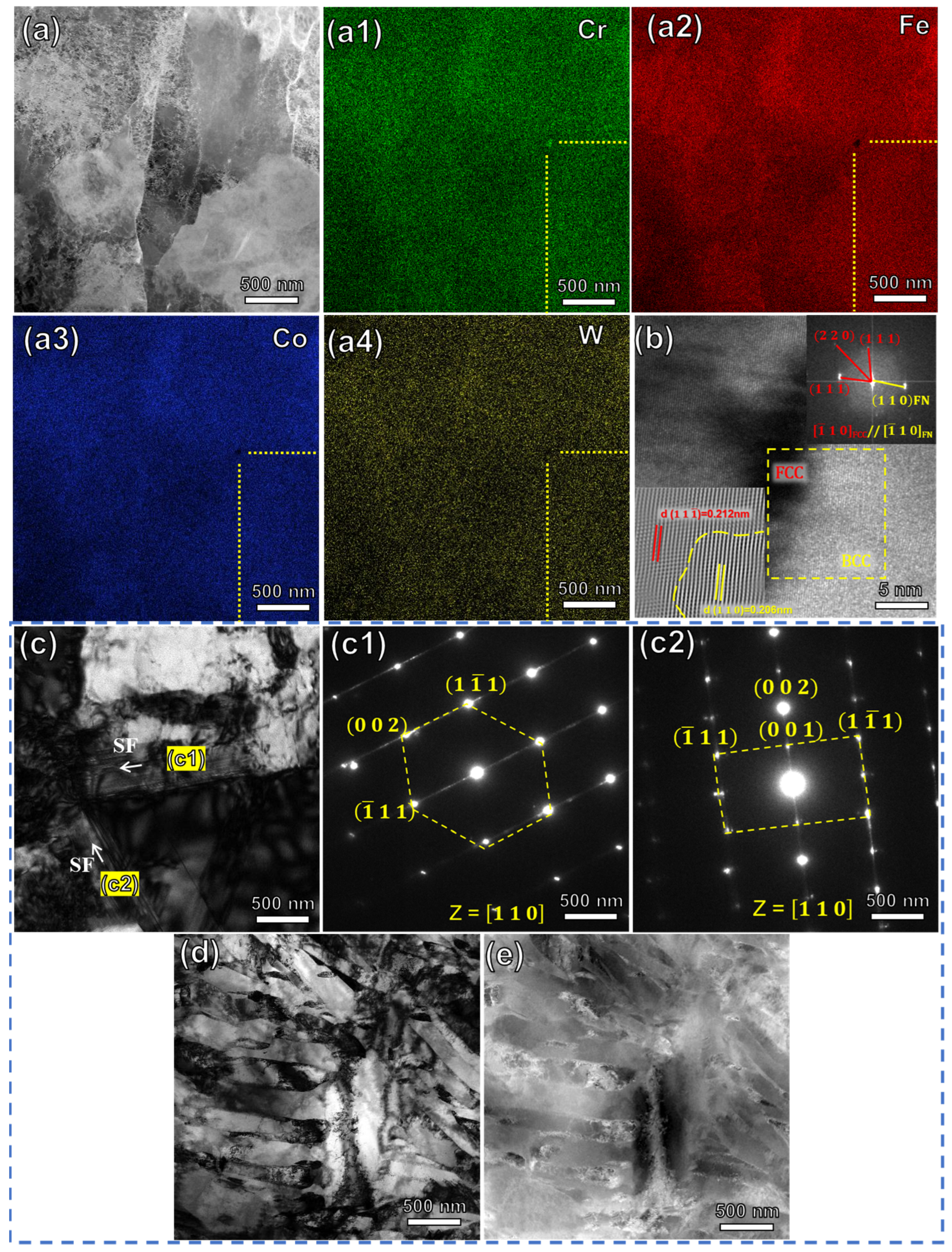
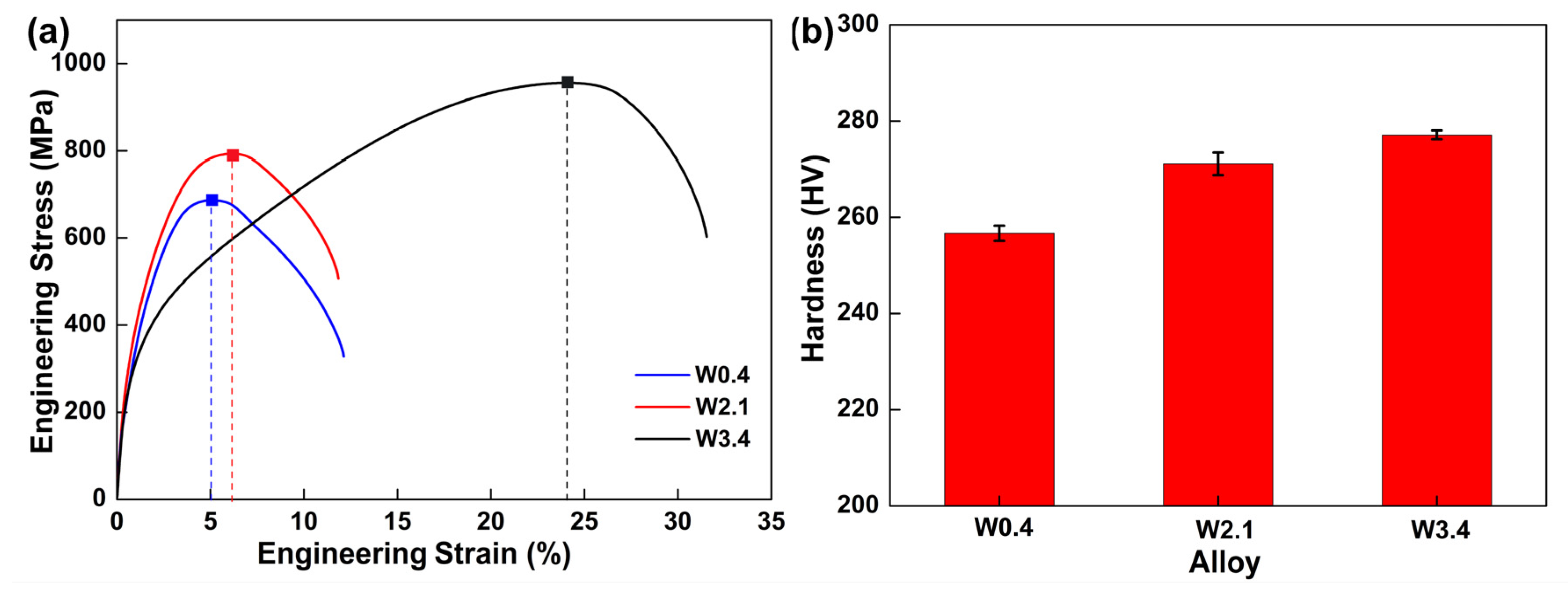
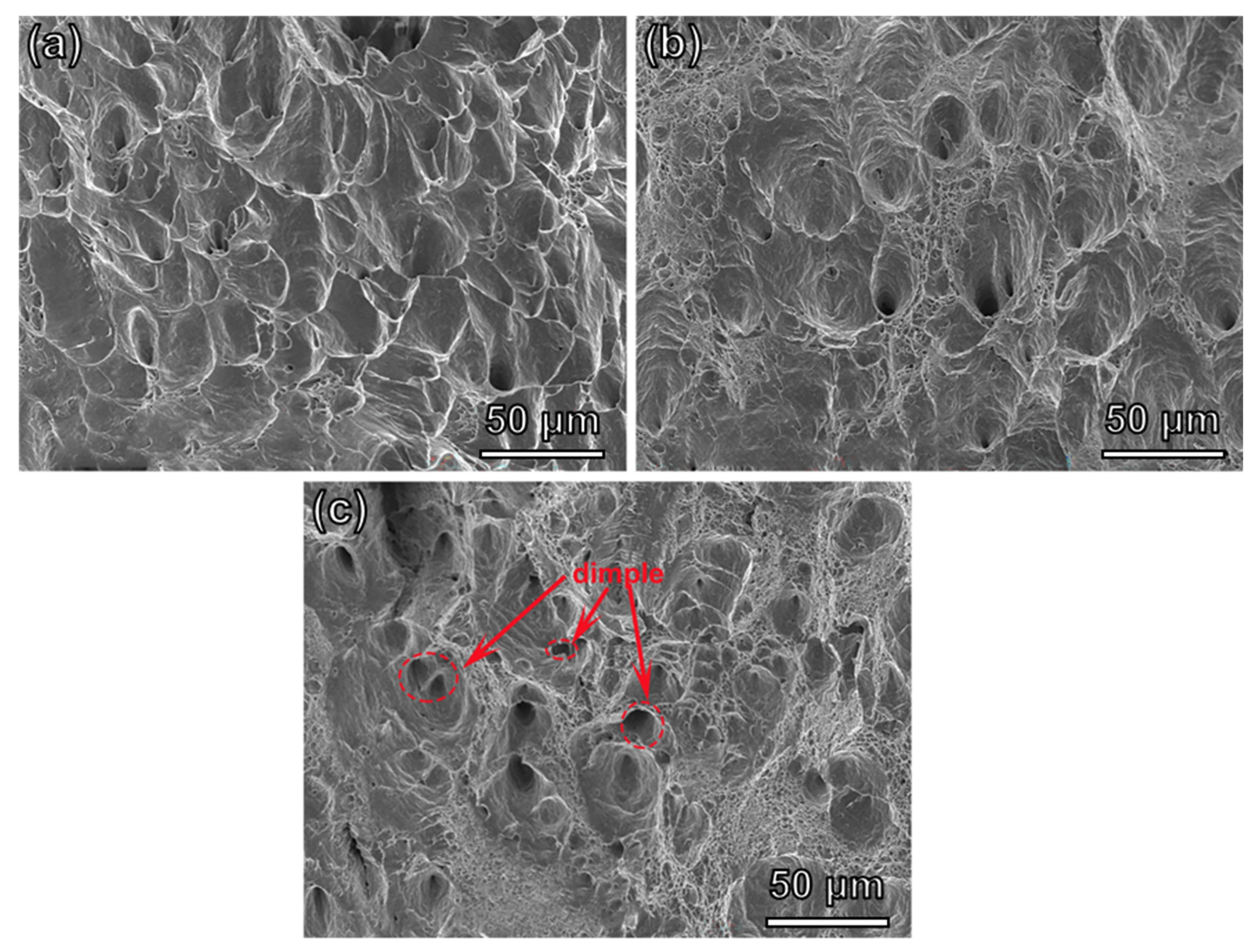

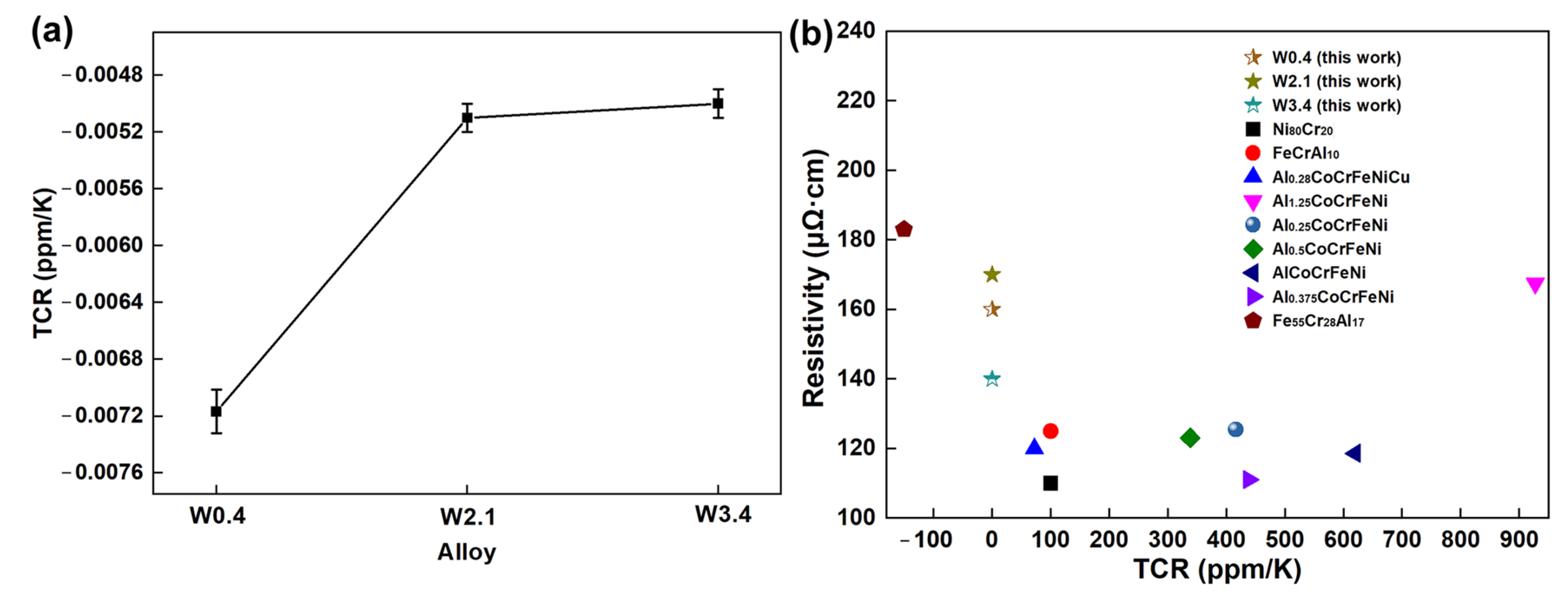
| Alloy | W/at% | Cr/at% | Co/at% | Fe/at% |
|---|---|---|---|---|
| W0.4 | 0.4 | 15.3 | 23.1 | Bal. |
| W2.1 | 2.1 | 15.8 | 23.3 | Bal. |
| W3.4 | 3.4 | 16.3 | 24.0 | Bal. |
| Alloy | Phase | {hkl} | Lattice Parameter/nm |
|---|---|---|---|
| W0.4 | BCC-α | (110) | 0.2870 |
| W2.1 | 0.2878 | ||
| 0.2877 | |||
| W3.4 | FCC-γ | (220) | 0.3582 |
| Alloy | UTS (MPa) | YS (MPa) | UE (%) |
|---|---|---|---|
| W0.4 | 687 ± 4.9 | 237 ± 2.7 | 5.0 ± 1.2 |
| W2.1 | 793 ± 3.1 | 301 ± 3.9 | 6.3 ± 2.9 |
| W3.4 | 956 ± 3.3 | 320 ± 4.1 | 24.2 ± 2.0 |
Disclaimer/Publisher’s Note: The statements, opinions and data contained in all publications are solely those of the individual author(s) and contributor(s) and not of MDPI and/or the editor(s). MDPI and/or the editor(s) disclaim responsibility for any injury to people or property resulting from any ideas, methods, instructions or products referred to in the content. |
© 2023 by the authors. Licensee MDPI, Basel, Switzerland. This article is an open access article distributed under the terms and conditions of the Creative Commons Attribution (CC BY) license (https://creativecommons.org/licenses/by/4.0/).
Share and Cite
Wang, H.; Zhang, H.; Liu, M.; Liu, J.; Yan, Z.; Zhang, C.; Li, Y.; Feng, J. The Effect of W Content on the Microstructure, Mechanics and Electrical Performance of an FeCrCo Alloy. Materials 2023, 16, 4319. https://doi.org/10.3390/ma16124319
Wang H, Zhang H, Liu M, Liu J, Yan Z, Zhang C, Li Y, Feng J. The Effect of W Content on the Microstructure, Mechanics and Electrical Performance of an FeCrCo Alloy. Materials. 2023; 16(12):4319. https://doi.org/10.3390/ma16124319
Chicago/Turabian StyleWang, Huiqi, Hui Zhang, Mangxian Liu, Jianqun Liu, Zhipeng Yan, Changming Zhang, Yapeng Li, and Junjun Feng. 2023. "The Effect of W Content on the Microstructure, Mechanics and Electrical Performance of an FeCrCo Alloy" Materials 16, no. 12: 4319. https://doi.org/10.3390/ma16124319
APA StyleWang, H., Zhang, H., Liu, M., Liu, J., Yan, Z., Zhang, C., Li, Y., & Feng, J. (2023). The Effect of W Content on the Microstructure, Mechanics and Electrical Performance of an FeCrCo Alloy. Materials, 16(12), 4319. https://doi.org/10.3390/ma16124319





